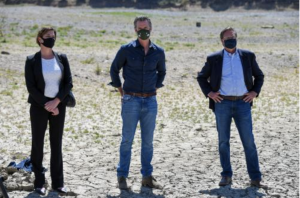Regional state of emergency proclaimed for Russian River Watershed to protect communities and reduce environmental impacts
UKIAH – With much of the West experiencing drought conditions and California squarely in a second consecutive dry year, Governor Gavin Newsom today directed state agencies to take immediate action to bolster drought resilience and prepare for impacts on communities, businesses and ecosystems if dry conditions extend to a third year.
In addition, the Governor proclaimed a regional drought emergency for the Russian River watershed in Sonoma and Mendocino counties, where reservoirs are at record lows following two critically dry years and accelerated action may be needed to protect public health, safety and the environment.
“California is facing the familiar reality of drought conditions, and we know the importance of acting early to anticipate and mitigate the most severe impacts where possible,” Governor Newsom said. “Climate change is intensifying both the frequency and the severity of dry periods. This ‘new normal’ gives urgency to building drought resilience in regions across the state and preparing for what may be a prolonged drought at our doorstep.”
The text of today’s emergency proclamation can be found here.


Governor Newsom announces regional drought emergency and executive actions to bolster water resilience.
With an extremely low Lake Mendocino as a backdrop, the Governor today announced that he is directing state agencies to work with regional and local governments – including groundwater sustainability agencies – to identify watersheds, communities, public water systems and ecosystems that may require coordinated state and local actions to address drought impacts and protect people, natural resources and economic activity.
To encourage Californians to reduce water use and conserve supplies in case drought conditions continue next year, the proclamation also directs state agencies to partner with local water suppliers to promote conservation tips and messages through the Save Our Water campaign. The campaign and website were critical resources for Californians during the 2012-2016 drought and remain a trusted information source on using water wisely.
The proclamation directs additional actions to coordinate with California Native American tribes; accelerate funding for water supply enhancement, conservation and species protection projects; work with counties to encourage and track reporting of household water shortages including dry residential wells; provide technical and financial assistance for water systems at risk of water shortages; support the agricultural economy and food security; and evaluate and take action to protect terrestrial and aquatic species.
To address acute drought impacts in the Russian River watershed, the proclamation directs the State Water Board to consider modifying requirements for reservoir releases or diversion limitations to ensure adequate supplies for critical purposes. The regional state of emergency also enables flexibilities in regulatory requirements and procurement processes to mitigate drought impacts.
Under the Governor’s direction, state agencies have been working together since November to prepare for continued dry conditions. The Governor recently formalized that coordination through the Drought Resilience Task Force, which includes the Natural Resources Agency, California Environmental Protection Agency, Department of Food and Agriculture, Department of Water Resources, Department of Fish and Wildlife, State Water Resources Control Board, Department of Finance, Governor’s Office of Emergency Services, California Health and Human Services Agency, California Public Utilities Commission and the Labor and Workforce Development Agency.
Other recent actions by state agencies to address dry conditions include:
- The state has launched a new drought preparedness website detailing current conditions, the state’s response and informational resources for the public.
- The State Water Board has identified water suppliers at extreme financial risk that may need additional support due to the combined impacts of COVID and drought.
- The Department of Water Resources (DWR) has updated its Dry Well website that tracks reports of water supply outages.
- DWR has drafted a Drought Contingency Plan that explains how it will manage the State Water Project in a manner that protects fish and wildlife.
- The State Water Board has issued letters to approximately 40,000 water right holders across the state, advising them to plan for potential shortages by closely managing water use.
- Last month, DWR released a report, prepared with extensive stakeholder involvement, that evaluates the water shortage risk of more than 4,000 small water providers.
- Informed by that report, this month the State Water Board completed its first-ever comprehensive look at California water systems that are struggling to provide safe drinking water to communities and how to help them. The assessment identifies both failing water systems and those at risk of failing, offering the most in-depth view of long-term drinking water safety the state has ever had.
- CDFA is coordinating closely with the USDA to provide aid to growers and ranchers in the Klamath Basin, and the Department of Fish and Wildlife is working with California Native American tribes and commercial and recreational salmon representatives to manage impacts to iconic salmon in the basin.
The 2012-2016 drought helped usher in some important water resilience policies that position the state to better handle another drought. These include:
- Enactment in 2014 of the Sustainable Groundwater Management Act to require and empower local agencies to bring overdrafted groundwater basins into sustainable conditions by 2042.
- Enactment of legislation to establish new standards for indoor, outdoor and industrial use of water.
- Funding for disadvantaged communities lacking access to safe drinking water through the Safe and Affordable Drinking Water Act.
- Increase in the frequency of water use reporting.
- Expanded state authority to order failing public water systems to consolidate with better-run systems.
- Tighter landscape efficiency standards for new developments.
###

